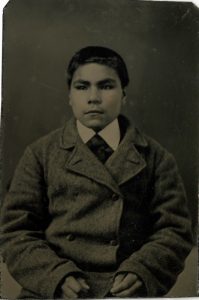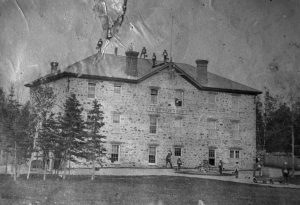1
Old buildings are notoriously vulnerable to fire, and so Shingwauk needed to have some kind of fire plan in place. This was especially important considering the first iteration of Shingwauk, built in Garden River, burnt down just 6 days after opening. The boys at the school were trained in the Fire Brigade, basically a line of students who would pass buckets of water back and forth in order to fight any flames that might break out in the building.
The following excerpt highlights the experience of two brothers at Shingwauk who were involved in the Fire Brigade, John and Joseph Esquimau. During the Christmas exams in 1876, John, aged approximately 22, won the Bishop’s prize for best conduct, the first division prize for progress, and the first prize for scripture and catechism.
His younger brother Joseph, aged approximately 14, won Bishop Fauquier’s prize for best general progress, the first prize in second division for progress, the second class prize for English, and the Fire Brigade prize.

In a letter to Bishop Fauquier, the Bishop of Algoma, in Letter Book 2014-117/001(001), Wilson tells a story about how Joseph beat his brother by one prize:
“Our examinations are just over – [John] Esquimau gets your prize for good conduct and Joseph Esquimau the other one for general advancement in all branches. In this he is one ahead of his brother – how it was – the following little anecdote will show. Among the prizes to be competed for was one to the Fire Brigade – for knowing the rules well and being prompt in obeying orders – [John] Esquimau as captain formed his brigade in line for passing pails but put Hander Number 4 in Number 1’s place and vice versa – Number 4 was Joseph – and I said to him you are in the wrong place you lose a mark – “No sir,” he replied, “I know it’s the wrong place but Captain put me here and I obeyed his orders” – a regular soldier’s reply. The Captain in consequence lost a mark and Joseph beat him in the total.”

This illustrated the regimentation of life in the school and the important of complying and following orders. This in turn reflects the wider efforts of the Residential School system to assimilate Indigenous children into Euro-Canadian society by having them act in ways that were deemed appropriate.

